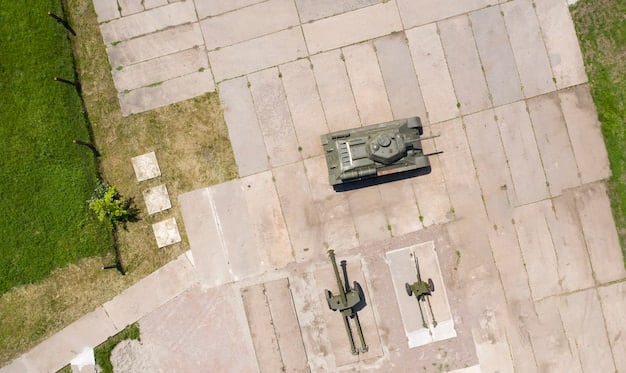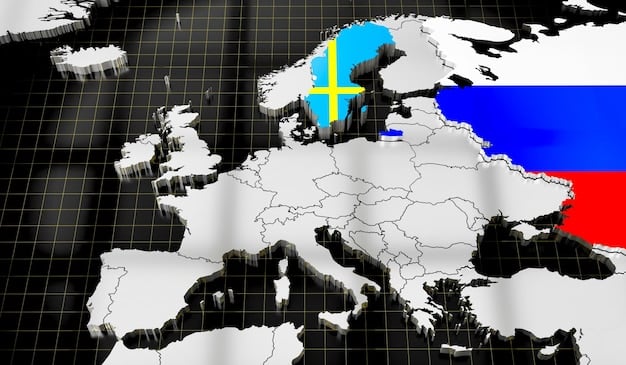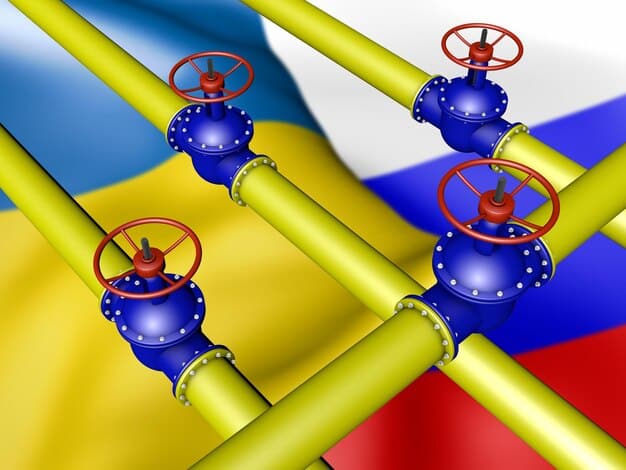US Response to Eastern Europe Tensions: A Political Strategy Analysis

How Will the US Respond to the Growing International Tensions in Eastern Europe? A Political Strategy Analysis delves into the multifaceted approaches the United States might adopt, considering diplomatic, economic, and military strategies, alongside the potential geopolitical implications for transatlantic relations and global stability.
The escalating tensions in Eastern Europe have triggered global concern, placing the United States in a pivotal position to respond. This article, How Will the US Respond to the Growing International Tensions in Eastern Europe? A Political Strategy Analysis, explores the strategies Washington might employ to navigate this complex geopolitical landscape.
Understanding the Geopolitical Landscape of Eastern Europe
Eastern Europe’s geopolitical landscape is a complex tapestry woven with historical rivalries, diverse national interests, and the overhanging shadow of great power competition. Understanding this landscape is crucial to analyzing potential US responses to growing international tensions.
This section provides an overview of the key players, the underlying tensions, and the potential flashpoints that could trigger further escalation. This understanding will aid in comprehending the strategic calculus behind potential US actions.
Key Regional Actors
Several nations wield significant influence in Eastern Europe, each with distinct agendas. Russia, Ukraine, Poland, and the Baltic states play pivotal roles, shaping regional dynamics and influencing the broader geopolitical balance.
Russia’s assertive foreign policy, particularly its actions in Ukraine, has heightened tensions, while countries like Poland and the Baltic states seek closer ties with NATO and the European Union to bolster their security. Ukraine, caught in the crossfire, strives to maintain its sovereignty and territorial integrity.
Sources of Tension
- Territorial Disputes: Lingering disputes over territory and borders contribute to instability.
- Energy Security: Control over energy resources and pipelines is a major source of conflict, especially between Russia and its neighbors.
- NATO Expansion: The prospect of further NATO expansion into Eastern Europe remains a contentious issue, viewed by Russia as a threat to its sphere of influence.
- Information Warfare: Disinformation campaigns and cyberattacks are used to undermine trust and sow discord.
These sources of tension create a volatile environment, demanding careful consideration of any US response.
In conclusion, the geopolitical complexity of Eastern Europe necessitates a nuanced understanding of the regional actors and the sources of conflict to develop effective strategies for de-escalation and stability.

US Diplomatic Strategies in Eastern Europe
Diplomacy constitutes a core element of the United States’ foreign policy toolkit. In the context of Eastern Europe, diplomatic strategies encompass a range of approaches aimed at de-escalating tensions, fostering dialogue, and promoting stability.
These strategies involve close collaboration with allies and partners, as well as direct engagement with adversaries, to navigate the complex geopolitical landscape effectively.
Multilateral Engagements
The US leverages its membership in international organizations such as the United Nations, NATO, and the Organization for Security and Co-operation in Europe (OSCE) to address the challenges in Eastern Europe.
Through these platforms, the US can mobilize international support for diplomatic initiatives, coordinate sanctions against aggressors, and facilitate peacekeeping operations. NATO, in particular, provides a framework for collective defense and deterrence, sending a strong signal to potential adversaries.
Bilateral Discussions
Direct engagement with key stakeholders, including Russia, Ukraine, and European allies, is vital for managing tensions and finding common ground. These bilateral discussions can address specific concerns, negotiate agreements, and explore opportunities for cooperation.
However, the success of bilateral diplomacy hinges on a clear understanding of the other party’s interests and red lines, as well as a willingness to compromise.
Support for Democracy and Civil Society
- Promoting democratic reforms and good governance.
- Strengthening civil society organizations and independent media.
- Supporting anti-corruption initiatives.
- Fostering people-to-people exchanges and educational programs.
These efforts aim to build resilience against authoritarian influence and promote long-term stability.
In summary, US diplomatic strategies in Eastern Europe encompass multilateral engagements, bilateral discussions, and support for democracy and civil society, all geared towards de-escalating tensions and fostering a more stable and peaceful environment.
Economic Tools and Sanctions Policy
Economic measures represent a significant component of the US strategy toward Eastern Europe. These tools range from providing financial assistance to imposing sanctions aimed at altering the behavior of specific actors.
Effective utilization of economic tools requires careful consideration of their potential impact on both the target country and the broader regional economy.
Financial Aid and Investment
Providing economic assistance to countries like Ukraine can help bolster their resilience against external pressure and promote economic reforms. Investment in key sectors, such as energy and infrastructure, can foster sustainable development and reduce dependence on potentially unreliable partners.
However, the effectiveness of financial aid depends on good governance and transparency to ensure that resources are used efficiently and effectively.
Sanctions Regimes
The US has employed sanctions against individuals and entities involved in activities that undermine the sovereignty and stability of Eastern European countries. These sanctions can include asset freezes, travel bans, and restrictions on financial transactions.
The goal of sanctions is to deter further aggression and encourage compliance with international norms. However, sanctions can also have unintended consequences, such as harming innocent civilians and disrupting trade.
Energy Policy and Diversification
- Supporting energy diversification projects that reduce dependence on Russian gas.
- Promoting alternative energy sources and energy efficiency.
- Working with European allies to ensure energy security.
These efforts aim to reduce Russia’s leverage over Eastern European countries and promote greater energy independence.
In essence, economic tools and sanctions policy play a vital role in the US strategy toward Eastern Europe, providing both carrots and sticks to promote stability and deter aggression.

Military Posture and Security Assistance
The United States maintains a significant military presence in Europe, aimed at deterring aggression and reassuring allies. In Eastern Europe, this posture is particularly important, given the heightened security concerns.
Security assistance programs further enhance the capabilities of partner nations to defend themselves and contribute to regional security.
Forward Deployment and Deterrence
The US has increased its military presence in Eastern Europe, deploying troops, equipment, and aircraft to forward locations. This forward deployment serves as a deterrent against potential aggression and demonstrates a commitment to collective defense.
Moreover, the US conducts regular military exercises with its allies in the region, enhancing interoperability and readiness.
Security Assistance Programs
The US provides security assistance to countries like Ukraine, Poland, and the Baltic states, helping them to modernize their armed forces and improve their defense capabilities. This assistance includes training, equipment, and advisory support.
By strengthening the defense capabilities of partner nations, the US enhances their ability to deter aggression and protect their sovereignty.
NATO Coordination and Burden Sharing
- Working with NATO allies to enhance the alliance’s collective defense capabilities.
- Encouraging European allies to increase their defense spending and contribute more to regional security.
- Coordinating military activities and intelligence sharing to ensure a unified response to potential threats.
These efforts aim to strengthen NATO’s deterrent posture and ensure that the burden of defense is shared fairly among allies.
In summary, military posture and security assistance are critical components of the US strategy toward Eastern Europe, providing both deterrence against potential aggression and support for partner nations to defend themselves.
Balancing Relations with Russia
Managing the relationship with Russia represents a central challenge for US foreign policy in Eastern Europe. While the US seeks to deter Russian aggression and uphold international norms, it also recognizes the need for dialogue and potential cooperation on issues of mutual interest.
Finding the right balance between these competing objectives requires a nuanced and pragmatic approach.
Areas of Engagement
Despite the tensions over Eastern Europe, the US and Russia share some common interests, such as arms control, counterterrorism, and nuclear non-proliferation. Engaging in dialogue and cooperation on these issues can help to build trust and reduce the risk of miscalculation.
However, any engagement with Russia must be based on a clear understanding of its objectives and a willingness to stand firm on core principles.
Red Lines and Deterrence
The US must clearly communicate its red lines to Russia, making it clear that aggression against Eastern European countries will not be tolerated. Credible deterrence is essential to prevent further escalation and maintain stability in the region.
This deterrence must be backed by a strong military posture, economic sanctions, and diplomatic pressure.
Managing Escalation
- Establishing clear communication channels to prevent misunderstandings and miscalculations.
- Developing protocols for managing potential crises and de-escalating tensions.
- Working with allies to coordinate responses and ensure a unified approach.
These measures aim to reduce the risk of unintended conflict and maintain stability in the region.
In essence, balancing relations with Russia requires a combination of deterrence, dialogue, and crisis management, all aimed at preventing further aggression and promoting a more stable and predictable relationship.
Future Challenges and Strategic Foresight
The challenges facing the US in Eastern Europe are likely to persist for the foreseeable future. Anticipating future developments and adapting strategies accordingly is crucial for maintaining stability and protecting US interests.
This requires constant monitoring of the geopolitical landscape, as well as investment in strategic foresight capabilities.
Emerging Technologies and Hybrid Warfare
The rise of new technologies, such as artificial intelligence, cyber warfare, and autonomous weapons, poses new challenges for security in Eastern Europe. Hybrid warfare tactics, which combine military force with disinformation, economic pressure, and political subversion, are also becoming increasingly prevalent.
The US must adapt its strategies to counter these emerging threats, investing in cybersecurity, intelligence gathering, and resilience-building measures.
Internal Political Dynamics
Internal political dynamics in both Eastern European countries and Russia can significantly impact the geopolitical landscape. Political instability, corruption, and democratic backsliding can create vulnerabilities that external actors can exploit.
The US must support democratic reforms and good governance in Eastern Europe, while also closely monitoring political developments in Russia.
Transatlantic Unity
- Maintaining a strong and unified transatlantic alliance.
- Ensuring that European allies are committed to burden sharing and collective defense.
- Addressing any divisions or disagreements that could undermine the alliance’s effectiveness.
These efforts are essential for maintaining a strong and coordinated response to the challenges in Eastern Europe.
In conclusion, addressing future challenges in Eastern Europe requires a proactive and adaptive approach, investing in strategic foresight, countering emerging threats, and maintaining transatlantic unity.
| Key Point | Brief Description |
|---|---|
| 🌍 Geopolitical Analysis | Understanding key actors and sources of tension in Eastern Europe. |
| 🤝 Diplomatic Strategies | Using multilateral and bilateral engagements to de-escalate conflict. |
| 💰 Economic Tools | Employing financial aid and sanctions to influence regional stability. |
| 🛡️ Military Posture | Maintaining a forward military deployment and providing security assistance. |
Frequently Asked Questions
▼
The primary drivers include territorial disputes, energy security concerns, NATO expansion, and information warfare, creating a complex geopolitical landscape.
▼
The US uses multilateral engagements through organizations like the UN and NATO, as well as bilateral discussions, to foster dialogue and promote stability.
▼
The US employs financial aid to bolster economies and imposes sanctions to deter aggressive behavior, aiming to promote economic and political stability.
▼
The US maintains a significant forward deployment to deter aggression and provides security assistance to partner nations, enhancing regional defense capabilities.
▼
The US balances deterrence with dialogue on mutual interests, establishing clear red lines while managing escalation risks through communication and coordination.
Conclusion
In conclusion, the US response to growing international tensions in Eastern Europe involves a multifaceted strategy encompassing diplomatic engagement, economic tools, military posture, and a balanced approach to relations with Russia. Navigating this complex landscape requires strategic foresight, adaptability, and a commitment to transatlantic unity to ensure long-term stability and protect US interests.





